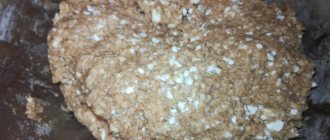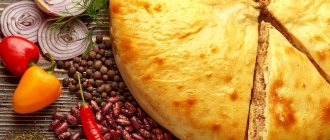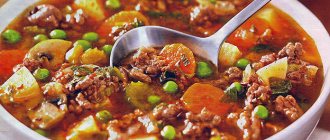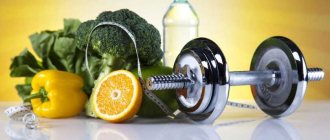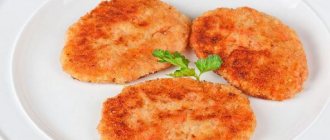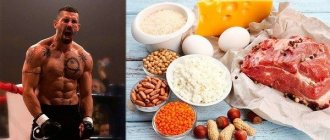Low glycemic index carbohydrates
Brown rice is quite high in calories at 340 calories, contains 8 grams of protein, 2 grams of fat and 72 grams of carbohydrates. Compared to white milled rice, which has a glycemic index of 80, brown rice contains several times more fiber, vitamins and microelements, which makes its biological value much higher. The dietary properties of brown rice, along with the high carbohydrate content, make this product one of the most successful for gaining high-quality muscle mass.
Brown rice is also a unique product that is also used in the diet. But its presence in the diet will no longer be at the level of 50-60%, but at the level of 30%.
The next product is buckwheat . Buckwheat is no less biologically valuable product than brown rice, but is already more dietary. Buckwheat has about the same glycemic index of just 50, but contains more protein - 12 grams, as well as 3 grams of fat and 62 grams of carbohydrates, while having an energy value of 315 calories.
Buckwheat is a pretty good product for gaining muscle mass, but its relatively low calorie content and low carbohydrate content do not allow it to become a favorite and compete with brown rice. Here it is impossible to say unequivocally which is better. You can gain weight on buckwheat, but often, especially in adolescence and the age of “full prime”, you have to maintain a high caloric intake and really eat a lot even when you don’t want to (relevant for ectomorphs).
Carbohydrates during weight gain[edit | edit code]
The single most important nutritional factor affecting muscle gain is calories. In particular, those obtained with carbohydrates. Building muscle requires following a rigorous strength program. And this requires a huge amount of energy, which is best supplied by carbohydrates.
.
A diet with a high content of them allows you to achieve maximum restoration of daily muscle glycogen reserves. The process of continuously replenishing these reserves helps the muscles work intensively for many days in a row. Research clearly shows that diets high in carbohydrates provide strength athletes with greater training efficiency. That is, the more intensely you exercise, the more muscle mass you can gain. Read more:
The best training programs for mass
To gain 0.5 kg of muscle, add 250 calories weekly. This means adding extra calories to your diet. Ideally, women should increase their caloric intake by 30 per day, and men by 40. Research has shown that these are the optimal numbers to start building muscle (without gaining fat). Read more:
Sports nutrition complex for gaining muscle mass
You should increase your calorie intake gradually to avoid gaining too much fat. Personally, I suggest that strength athletes start by adding an extra 30 to 35 calories per day to their diet. Then, after a week or two, you can add another 30-40 calories per day. If you still don't gain body fat, start adding 30 to 40 extra calories each week. (By the way, to burn fat, you can reduce the number of calories in the same amount: 30 per day for women and 40 for men.)
But let's get back to increasing the number of calories. Most of these additional calories should come from carbohydrates in regular foods and in the form of liquid carbohydrate supplements. So, you can get 300-400 carbohydrate calories by eating, for example, half a cup (70 grams) of pasta, half a lamb and one banana. You don't have to eat a lot to increase your daily intake of carbohydrates. Next, I'll show you how to properly time your carbohydrate intake and pair extra carbohydrates with the right types of foods to speed up the muscle-building process.
When I work with a specific client, I need to make sure that their body's protein and fat needs are fully met. And only after that I pay attention to carbohydrate consumption. Thus, by increasing or decreasing the proportion of carbohydrate calories, I can balance their volume. Carbohydrate calories are fuel. Therefore, to gain weight, their number must increase, and to reduce the proportion of fat, it must decrease.
Protein foods for gaining muscle mass
Surely you already know that in order to build muscles, you need building material, that is, protein. When choosing the same building material, we give preference to products that are fully balanced in essential amino acids and are well absorbed.
Here you can also highlight several of the most successful products. These are chicken breasts, fish and seafood, fermented milk products, and egg whites.
Chicken breasts.
This is a fairly successful “building material” for muscle growth, which contains 24 grams of protein, 2 grams of fat and less than 1 gram of carbohydrates. Calorie content is approximately 113. If you compare chicken breast with other meat products, you can note several of its advantages: low fat content and a thinner cell membrane compared to pork or beef.
However, the same cell membrane and, accordingly, absorption are inferior to fish and seafood .
Different types of fish have a thinner cell membrane and are digested better than all types of meat and poultry.
What foods are sources of complex carbohydrates?
- All legumes except soybeans;
- Cereals, except semolina and white rice (instead of white, brown, unprocessed rice is preferable);
- Corn;
- Whole wheat pasta;
- Whole grain bread made from coarse grains with bran;
- Fruits - kiwi, grapefruit, apples, pears, oranges, avocados and peaches;
- Berries (raspberries and cherries);
- Dried fruits;
- Vegetables (any type of cabbage, tomatoes, zucchini, bell peppers, onions, leeks, green beans);
- Greens (lettuce, parsley, dill, green onions, spinach);
- Mushrooms.
List of foods containing slow carbohydrates table
Low glycemic index foods (suitable for any meal)
| Dried apricots | 35 | Amaranth | 35 |
| Anona | 35 | Chocolate bar without sugar Montignac) | 35 |
| Smooth peach, nectarine (fresh fruit) | 35 | Cassoulet (French dish) | 35 |
| Celery root (raw) | 35 | Quince (fresh fruit) | 35 |
| Creamy ice cream (fructose) | 35 | Falafel (chickpea) | 35 |
| Figs, Opuntia fruits (fresh fruit) | 35 | Chickpea flour | 35 |
| Adzuki beans | 35 | Pomegranate (fresh fruit) | 35 |
| White beans, cannellini | 35 | Borlotti beans | 35 |
| Red beans | 35 | Black beans | 35 |
| Zhorzhzhi | 35 | Tomato juice | 35 |
| Flax-seed | 35 | Brewer's yeast | 35 |
| Sesame, poppy | 35 | Wild corn | 35 |
| Mustard | 35 | Orange (fresh fruit) | 35 |
| Sprouted grain bread | 35 | Peach (fresh fruit) | 35 |
| Chickpeas (canned) | 35 | Green peas (fresh) | 35 |
| Apple (fresh fruit) | 35 | Apple (compote, stewed) | 35 |
| Plum (fresh fruit) | 35 | Dried apples | 35 |
| Quinoa | 35 | Sugar-free almond paste | 35 |
| Tomato sauce without sugar | 35 | Wild rice | 35 |
| Sunflower seeds | 35 | Dried tomatoes | 35 |
| Wasa crispbread (24% fiber) | 35 | Durum wheat vermicelli | 35 |
| Yogurt (natural) | 35 | Soy yogurt (flavored) | 35 |
| Apricot (fresh fruit) | 30 | Whole grain bread Montignac | 34 |
| Beetroot (raw) | 30 | Garlic | 30 |
| Cottage cheese **(natural) | 30 | Carrots (raw) | 30 |
| Green beans, green beans | 30 | passion fruit | 30 |
| Oat milk (raw) | 30 | Soy milk | 30 |
| Powdered milk** | 30 | Almond milk | 30 |
| Brown lentils | 30 | Milk** (any fat content) | 30 |
| Tangerines, clementines | 30 | Yellow lentils | 30 |
| Turnip (raw) | 30 | Marmalade (no sugar) | 30 |
| Pear (fresh fruit) | 30 | Grapefruit (fresh fruit) | 30 |
| Kozelets, oat root | 30 | Chickpeas | 30 |
| Soy vermicelli | 30 | Tomatoes | 30 |
| Goji berries | 25 | Blueberry | 25 |
| Dark chocolate (>70% cocoa) | 25 | Cherry | 25 |
| Flajole beans | 25 | Soy flour | 25 |
| Raspberries | 25 | Strawberry | 25 |
| Red currants | 25 | Pumpkin seeds | 25 |
| Mungo beans (soy) | 25 | Gooseberry | 25 |
| Green lentils | 25 | Hummus | 25 |
| Barley | 25 | Blackberry | 25 |
| Chopped peanuts (no sugar) | 25 | Peas Dry | 25 |
| Almond paste (no sugar) | 25 | Ground hazelnuts (hazelnuts) into paste | 25 |
| Eggplant | 20 | Artichoke | 20 |
| Acerola | 20 | Cocoa powder (no sugar) | 20 |
| Lemon | 20 | Dark chocolate (>85% cocoa) | 20 |
| Palm pulp (core) | 20 | Confiture without sugar Montignac | 20 |
| Almond flour | 20 | Hazelnut flour | 20 |
| Lemon juice | 20 | Fructose Montignac | 20 |
| Ratatouille | 20 | Bamboo shoots | 20 |
| Dry products (soy meat, etc.) | 20 | Soy sauce | 20 |
| Agave syrup | 15 | Soy yogurt (natural) | 20 |
| Asparagus | 15 | Almond | 15 |
| Broccoli | 15 | Chard, Swiss chard | 15 |
| Celery stalks | 15 | Peanut | 15 |
| Champignons, mushrooms | 15 | Cereal sprouts (soybeans, wheat) | 15 |
| Sauerkraut | 15 | Cauliflower | 15 |
| Brussels sprouts | 15 | Cabbage | 15 |
| Gherkins, pickled cucumbers | 15 | Cucumber | 15 |
| Shallot | 15 | Zucchini, zucchini | 15 |
| Spinach | 15 | Endive | 15 |
| Ginger | 15 | Fennel | 15 |
| Black currant | 15 | Cereal germs | 15 |
| Lupine | 15 | Green peas | 15 |
| Walnuts | 15 | Hazelnuts | 15 |
| Onion | 15 | Cashew | 15 |
| Sorrel | 15 | Olives | 15 |
| Physalis | 15 | Pesto | 15 |
| Pimento | 15 | Pine nuts | 15 |
| Leek | 15 | Pistachios | 15 |
| Bell pepper | 15 | Chicory vegetable | 15 |
| Radish | 15 | Carob powder | 15 |
| Green salad (different types) | 15 | Rhubarb | 15 |
| Bran (wheat, oat...) | 15 | Soybeans | 15 |
| Tofu (soy) | 15 | Tempeh (fermented soy product) | 15 |
| Pasta Montignac | 10 | Avocado | 10 |
| Lobster, crab, lobster | 5 | Spaghetti Montignac | 10 |
| Vinegar | 5 | Spices | 5 |
What is the glycemic index?
This is an indicator of the rate of breakdown of saccharides. The glycemic index of slow carbohydrate foods is low. That is why they slowly increase blood sugar levels. Products with a low glycemic index do not begin to be absorbed immediately as they enter our mouths, but are slowly absorbed through the intestinal walls. Thus, there is no sharp jump in carbohydrates in the blood. As a result, insulin is at normal levels, mood is normal, there is no fat.
How and in what quantity should you consume carbohydrates?
Carbohydrates are the basis of the diet, starting with breakfast. The ideal option is oatmeal with fruits and dried fruits.
Carbohydrates are also eaten as side dishes - porridge and potatoes (just don’t overuse fats, or don’t try to eat healthy at all!)
Adherents of a carbohydrate diet eat mainly porridge WITHOUT adding oil and salt (but honey, fruits and nuts are allowed, within reasonable limits, of course). Portions are not limited (saturation still occurs quickly). It is advisable to drink a glass of water 15-20 minutes before each meal.
A carbohydrate diet is useful no more often than once every six months and no longer than 10-15 days. In the process, you need to eat vitamins - do not forget, the body also has its own needs, which, despite the diet, must be met daily. These are vitamins, minerals and trace elements that are not always found in foods rich in slow carbohydrates.
The withdrawal from such a diet should proceed slowly, with the gradual addition of foods that contradict the carbohydrate diet.
And last but not least...
Slow carbohydrates for weight gain
We are, naturally, talking about athletes for whom nutrition and body weight are strictly interconnected. Their goal is to gain muscle mass.
Everyone knows that for strong muscles and beautifully sculpted muscles, athletes first of all need protein. But about protein in more detail another time. What are the benefits of carbohydrates?
An athlete's diet should contain 90% slow carbohydrates. They break down slowly, provide a lot of energy and are not stored as fat. Mandatory products for those who want to gain muscle mass with regular exercise are potatoes, vegetables, pasta (from coarse grains), cereals, nuts.
Foods with healthy fats
Speaking of fats, both when bulking and when dieting we need unsaturated fats, which are found in plant-based foods, such as nuts. And also in products such as fish. While you are bulking, you should not consume any foods to obtain fat; you will already get the required amount from normal foods - cereals, meat, fish, nuts.
Result:
In general, to grow muscle mass, the body must receive not only a sufficient amount of proteins, fats and carbohydrates, but also sufficient calories. There is no specific formula here - everyone has their own metabolism and the body’s need for calories to gain weight. Calorie intake should be increased until you begin to grow.
Where do you get (get) these carbohydrates from? (sources)
As you may know, there are two types of carbohydrates:
- COMPLEX (aka slow and useful);
- SIMPLE (they are fast, not useful/harmful).
More details about all this in the main article: “Carbohydrates in bodybuilding.”
In short, you need, of course, to consume COMPLEX CARBS and avoid simple ones in order to minimize the accumulation of excess fat and avoid various diseases.
The main complex carbohydrates (which are counted) are cereals (in our field, the most popular, which are used by absolutely all jocks, are rice and buckwheat, a little less often oatmeal (often in the morning, many people like it), and durum wheat pasta):
This is the food you should eat, and this is what you need to count first.
Vegetables and fruits are also formally sources of carbohydrates...

However, as a rule, pitchers do not take them into the main accounting (counting) (well, here it is, everyone at their own discretion, some count, others don’t, for example, I keep records only of cereals). This is the first point. The second point is that FRUITS = contain a lot of simple sugars , so their consumption should be limited and consumed only in the first half of the day (before 15.00).
Classification of carbohydrates
Carbohydrates are the main source of energy for the human body. According to their structure, they are divided into simple and complex. The first ones are quickly absorbed and give an instant feeling of satiety. But at the same time, they increase blood sugar levels, as a result of which metabolic processes slow down. Within a few minutes after eating, simple carbohydrates are transformed into sugar, which then turns into fat deposits. These chemical compounds are found in milk, fruits, some vegetables and sweets.

Sweets contain fast carbohydrates, so they will quickly satisfy your hunger - but soon you will want to eat again.
Slow carbohydrates have a complex structure and take a long time to digest, providing the body with energy for a long time. They are useful for dieting because they provide a quick and lasting feeling of fullness and promote proper digestion. Contained in grains and legumes, beets, potatoes, carrots, seeds, nuts. Do not lead to insulin spikes in the blood.
Complex carbohydrates are divided into several types:
- Starch, which consists of a large number of glucose molecules. It dissolves in water and normalizes digestion. Contained in rice, potatoes, buckwheat, pasta.
- Fiber, the structure of which is so complex that it is only partially digested. Reduces cholesterol levels and makes food digestion more efficient. Contained in whole grain cereals, apples, kiwis, grapes, nuts, and vegetables.
- Glycogen – accumulates in the body as an energy reserve. Included in fish, liver and other offal.
- Pectin is a polysaccharide that destroys toxins and other harmful substances. Contained in root vegetables, cucumbers, cherries.




